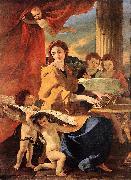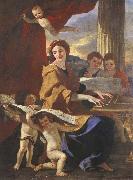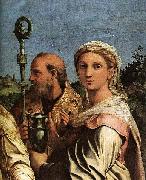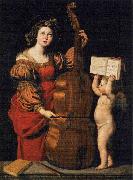Wholesale Oil Painting No Minimum |
|||||||||||
|
|
|||||||||||

|
|||||||||||
|
|
|
||||||||
Nicolas PoussinFrench 1594-1665 Nicolas Poussin Galleries The finest collection of Poussin's paintings, in addition to his drawings, is located in the Louvre in Paris. Besides the pictures in the National Gallery and at Dulwich, England possesses several of his most considerable works: The Triumph of Pan is at Basildon House, near to Pangbourne, (Berkshire), and his great allegorical painting of the Arts at Knowsley. The later version of Tancred and Erminia is at the Barber Institute in Birmingham. At Rome, in the Colonna and Valentini Palaces, are notable works by him, and one of the private apartments of Prince Doria is decorated by a great series of landscapes in distemper. Throughout his life he stood aloof from the popular movement of his native school. French art in his day was purely decorative, but in Poussin we find a survival of the impulses of the Renaissance coupled with conscious reference to classic work as the standard of excellence. In general we see his paintings at a great disadvantage: for the color, even of the best preserved, has changed in parts, so that the harmony is disturbed; and the noble construction of his designs can be better seen in engravings than in the original. Among the many who have reproduced his works, Audran, Claudine Stella, Picart and Pesne are the most successful. |
||||||||
|
|
||||||||
St Cecilia
St Cecilia Painting ID:: 10085 |
1627-28
Oil on canvas,
118x88cm Museo
del Prado, Madrid 1627-28 Oil on canvas, 118x88cm Museo del Prado, Madrid |
|||||||
|
|
||||||||
Nicolas PoussinFrench 1594-1665 Nicolas Poussin Galleries The finest collection of Poussin's paintings, in addition to his drawings, is located in the Louvre in Paris. Besides the pictures in the National Gallery and at Dulwich, England possesses several of his most considerable works: The Triumph of Pan is at Basildon House, near to Pangbourne, (Berkshire), and his great allegorical painting of the Arts at Knowsley. The later version of Tancred and Erminia is at the Barber Institute in Birmingham. At Rome, in the Colonna and Valentini Palaces, are notable works by him, and one of the private apartments of Prince Doria is decorated by a great series of landscapes in distemper. Throughout his life he stood aloof from the popular movement of his native school. French art in his day was purely decorative, but in Poussin we find a survival of the impulses of the Renaissance coupled with conscious reference to classic work as the standard of excellence. In general we see his paintings at a great disadvantage: for the color, even of the best preserved, has changed in parts, so that the harmony is disturbed; and the noble construction of his designs can be better seen in engravings than in the original. Among the many who have reproduced his works, Audran, Claudine Stella, Picart and Pesne are the most successful. |
||||||||
|
|
||||||||
|
|
St Cecilia
St Cecilia Painting ID:: 55765 |
mk244
Oil on canvas
118x88cm
mk244 Oil on canvas 118x88cm |
||||||
|
|
||||||||
RAFFAELLO SanzioItalian High Renaissance Painter, 1483-1520 Italian painter and architect. As a member of Perugino's workshop, he established his mastery by 17 and began receiving important commissions. In 1504 he moved to Florence, where he executed many of his famous Madonnas; his unity of composition and suppression of inessentials is evident in The Madonna of the Goldfinch (c. 1506). Though influenced by Leonardo da Vinci's chiaroscuro and sfumato, his figure types were his own creation, with round, gentle faces that reveal human sentiments raised to a sublime serenity. In 1508 he was summoned to Rome to decorate a suite of papal chambers in the Vatican. The frescoes in the Stanza della Segnatura are probably his greatest work; the most famous, The School of Athens (1510 C 11), is a complex and magnificently ordered allegory of secular knowledge showing Greek philosophers in an architectural setting. The Madonnas he painted in Rome show him turning away from his earlier work's serenity to emphasize movement and grandeur, partly under Michelangelo's High Renaissance influence. The Sistine Madonna (1513) shows the richness of colour and new boldness of compositional invention typical of his Roman period. He became the most important portraitist in Rome, designed 10 large tapestries to hang in the Sistine Chapel, designed a church and a chapel, assumed the direction of work on St. Peter's Basilica at the death of Donato Bramante, |
||||||||
|
|
||||||||
|
|
St Cecilia
St Cecilia Painting ID:: 63785 |
220 x 136 cm Pinacoteca Nazionale, Bologna Raphael probably accompanied Leo X when he went to Bologna to meet the King of France, Francis I, in 1515. He may have passed through Florence, where Leo was welcomed with great enthusiasm by his fellow citizens. Leonardo da Vinci - who later accepted the French King's invitation to Paris - and Michelangelo - to whom Leo X commissioned the New Sacristy of San Lorenzo - also followed the Pope. A letter which Raphael sent to the painter, Francesco Francia, provides proof of this journey. According to a legend, Francesco Francia died after seeing the St Cecilia which Raphael painted for the Church of San Giovanni in Monte in Bologna. The story is almost credible, for the Bolognese artistic environment still revolved around the style of Perugino. The painting was commissioned by Elena Duglioli dall'Olio of Bologna. She was famous for having visions and ecstatic fits in which music played a great part, which is probably why she asked for a picture of St Cecilia, the patron saint of music. Raphael decided on a painting in the style of a Sacra Conversazione, with St Cecilia in the centre surrounded by saints. The altarpiece, which is now in the Museum of Bologna, was placed in San Giovanni in Monte in 1515. It was painted some time before, however. The glorification of purity is the central idea behind this painting. This is expressed by the figures seen on both sides of the principal figure: St John the Evangelist is the patron saint of the church, and St Paul symbolizes innocence, while St Augustine and St Mary Magdalene stand for purity regained through atonement after sinful aberration. The four saints who surround the protagonist form a niche which is strengthened by the poses and gestures of the figures (the glances of the Evangelist and St Augustine cross, St Paul's is lowered and the Magdalene turns hers toward the spectator). Only St Cecilia raises her face toward the sky, where a chorus of angels appears through a hole in the clouds. The monumentality of the figures, typical of Raphael's activity during this period, dominates the other figurative elements. In the legend of St Cecilia, too, the painter emphasizes her desire to preserve her purity. As they were escorting Cecilia to the house of her betrothed, to the accompaniment of musical instruments, in her heart she called out only to God, beseeching Him to preserve the chastity of her heart and her body. So runs the fifth-century legend, and accordingly in this picture Cecilia does not hear the profane music, her eyes raised toward the heavens connects her directly with the choir of angels. This much is in complete agreement with the story of the Roman martyr.Artist:RAFFAELLO Sanzio Title: St Cecilia Painted in 1501-1550 , Italian - - painting : religious 220 x 136 cm Pinacoteca Nazionale, Bologna Raphael probably accompanied Leo X when he went to Bologna to meet the King of France, Francis I, in 1515. He may have passed through Florence, where Leo was welcomed with great enthusiasm by his fellow citizens. Leonardo da Vinci - who later accepted the French King's invitation to Paris - and Michelangelo - to whom Leo X commissioned the New Sacristy of San Lorenzo - also followed the Pope. A letter which Raphael sent to the painter, Francesco Francia, provides proof of this journey. According to a legend, Francesco Francia died after seeing the St Cecilia which Raphael painted for the Church of San Giovanni in Monte in Bologna. The story is almost credible, for the Bolognese artistic environment still revolved around the style of Perugino. The painting was commissioned by Elena Duglioli dall'Olio of Bologna. She was famous for having visions and ecstatic fits in which music played a great part, which is probably why she asked for a picture of St Cecilia, the patron saint of music. Raphael decided on a painting in the style of a Sacra Conversazione, with St Cecilia in the centre surrounded by saints. The altarpiece, which is now in the Museum of Bologna, was placed in San Giovanni in Monte in 1515. It was painted some time before, however. The glorification of purity is the central idea behind this painting. This is expressed by the figures seen on both sides of the principal figure: St John the Evangelist is the patron saint of the church, and St Paul symbolizes innocence, while St Augustine and St Mary Magdalene stand for purity regained through atonement after sinful aberration. The four saints who surround the protagonist form a niche which is strengthened by the poses and gestures of the figures (the glances of the Evangelist and St Augustine cross, St Paul's is lowered and the Magdalene turns hers toward the spectator). Only St Cecilia raises her face toward the sky, where a chorus of angels appears through a hole in the clouds. The monumentality of the figures, typical of Raphael's activity during this period, dominates the other figurative elements. In the legend of St Cecilia, too, the painter emphasizes her desire to preserve her purity. As they were escorting Cecilia to the house of her betrothed, to the accompaniment of musical instruments, in her heart she called out only to God, beseeching Him to preserve the chastity of her heart and her body. So runs the fifth-century legend, and accordingly in this picture Cecilia does not hear the profane music, her eyes raised toward the heavens connects her directly with the choir of angels. This much is in complete agreement with the story of the Roman martyr.Artist:RAFFAELLO Sanzio Title: St Cecilia Painted in 1501-1550 , Italian - - painting : religious |
||||||
|
|
||||||||
RAFFAELLO SanzioItalian High Renaissance Painter, 1483-1520 Italian painter and architect. As a member of Perugino's workshop, he established his mastery by 17 and began receiving important commissions. In 1504 he moved to Florence, where he executed many of his famous Madonnas; his unity of composition and suppression of inessentials is evident in The Madonna of the Goldfinch (c. 1506). Though influenced by Leonardo da Vinci's chiaroscuro and sfumato, his figure types were his own creation, with round, gentle faces that reveal human sentiments raised to a sublime serenity. In 1508 he was summoned to Rome to decorate a suite of papal chambers in the Vatican. The frescoes in the Stanza della Segnatura are probably his greatest work; the most famous, The School of Athens (1510 C 11), is a complex and magnificently ordered allegory of secular knowledge showing Greek philosophers in an architectural setting. The Madonnas he painted in Rome show him turning away from his earlier work's serenity to emphasize movement and grandeur, partly under Michelangelo's High Renaissance influence. The Sistine Madonna (1513) shows the richness of colour and new boldness of compositional invention typical of his Roman period. He became the most important portraitist in Rome, designed 10 large tapestries to hang in the Sistine Chapel, designed a church and a chapel, assumed the direction of work on St. Peter's Basilica at the death of Donato Bramante, |
||||||||
|
|
||||||||
|
|
St Cecilia
St Cecilia Painting ID:: 89861 |
1514(1514)
Medium Oil transferred from panel to canvas
Dimensions Width: 60 cm (23.6 in). (of detail)
cjr 1514(1514) Medium Oil transferred from panel to canvas Dimensions Width: 60 cm (23.6 in). (of detail) cjr |
||||||
|
|
||||||||
Domenichino1581-1641 Italian Domenichino Locations Italian painter and draughtsman. On the basis of his frescoes and altarpieces he became established as the most influential exponent of the 17th-century classical style. Through his critical analysis of the art of Raphael and Annibale Carracci he was influential in the creation of a modern canon of the ancients; and he was perhaps the most complete example of a 17th-century artist struggling to reconcile tradition with the demand for spectacle. |
||||||||
|
|
||||||||
|
|
St Cecilia
St Cecilia Painting ID:: 96046 |
between 1617(1617) and 1618(1618)
Medium oil on canvas
cyf between 1617(1617) and 1618(1618) Medium oil on canvas cyf |
||||||
|
|
||||||||
|
Domenichino 1581-1641 Italian Domenichino Locations Italian painter and draughtsman. On the basis of his frescoes and altarpieces he became established as the most influential exponent of the 17th-century classical style. Through his critical analysis of the art of Raphael and Annibale Carracci he was influential in the creation of a modern canon of the ancients; and he was perhaps the most complete example of a 17th-century artist struggling to reconcile tradition with the demand for spectacle. St Cecilia between 1617(1617) and 1618(1618) Medium oil on canvas cyf |
||||||||
|
|
||||||||
|
Prev Next
|
||||||||
|
|
||||||||
|
Related Paintings to Domenichino :. |
||||||||
|
|
||||||||
|
CONTACT US |





